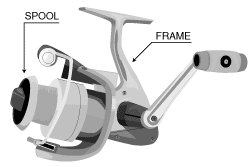Nov 26, 2024
Saltwater Reels
Take the guesswork out of choosing the reel you need for salt water fishing. Our guide explains the basics.
How To Buy Saltwater Reels
Finding a reel to go saltwater fishing starts with three basic considerations: your experience, your preferred way of fishing and the type of fish you're after. You then have a choice of several styles of reels to get the job done.
How to buy saltwater reels

Types
There are basically two types of reels to consider, each with advantages to weigh:baitcasting and spinning.
- Baitcasting reels
- Baitcasting reels are typically preferred by more experienced anglers, especially when using heavier lures and lines designed for bigger fish
- The reel works with the weight of the bait or lure as it pulls on the line and turns the spool to release more line. The heavier the lure, the longer the cast.
- With practice, this style of reel also will allow you to cast more accurately
- Many fishermen also prefer baitcasting for fighting bigger, stronger fish over an extended period, especially big game fish in saltwater
- The line retrieves directly on the spool making the baitcasting reel equal to the challenge
- Baitcasting reels are offered in one-piece designs, which lessens the corrosive effects of saltwater
- Most baitcasting reels now incorporate a drag system designed to adjust theresistance--or drag--on the spool to control how much resistance is needed to pull the right amount of line off the spool
- You can also select a baitcasting reel for your particular style of fishing
- Offshore reels are designed to fight large fish from a boat
- Trolling reels allow you to drag live bait or a lure as you troll in a boat
- Jigging reels allow you to cast a lure near the bottom and then pull the lure in an up and down motions
- Casting reels give you the benefit of precision casts
- Bottom reels, as their name sounds, allow you to fish from stationary boats and go down deep
- Spinning reels
- Spinning reels are open-faced
- Your line is released from a stationary spool by flipping a bail wire, a piece of metal wire across the spool called a bail
- This stationary spool keeps the line in place and helps prevent snarls and tangles
- The weight of your lure or bait propels the line forward
- Spinning reels can handle smaller baits but today's spinning reels are designed for light fishing to heavier fish
- You also need to ensure that your reel is a left- or right-hand retrieve, or can be adapted for either hand
- Spinning reels use an anti-reverse, a simple mechanism you set by letting go of the bail wire after casting. This keeps your line from spooling off once you get a strike from a fish.
- In saltwater spinning reels, you may prefer a skirted spool
- The skirted spool increases line capacity, allows longer casts and reduces tangles
- It also protects the reel's inside workings from the saltwater and moisture
Materials/Construction
There are a number of options available in saltwater fishing reels.
- Spools
- The spool is the part of the reel that holds the line
- It is a detachable component of the reel
- Spools are made of either graphite or aluminum
- Graphite spools are designed to be lighter than aluminum spools
- Aluminum spools generally cost more and some consider aluminum to be more durable; it's worthwhile to pay for anodized or machined bronze aluminum to fend off the corrosive effects of saltwater and moisture
- Either material is designed to resist corrosion from the water
- Frames
- The frame is what gives the reel its shape
- Frames can also be either made of graphite or aluminum
- Once again, this is a question of weight and the price you are willing to pay for a reel
- Line capacity
- Line capacity is a key consideration in selecting a reel
- Some reels can handle as much as 900 yards
- The amount of line you'll need depends on your type of fishing
- Gear ratio
- Gear ratio tells you how quickly a reel will retrieve line per revolution of your reel's crank
- Lower ratios provide more power for bringing fish from deeper depths, while higher gear rations benefit when pulling fish from closer to the surface
- Ball bearings
- Ball bearings are used to help reels work more smoothly by supporting the moving parts
- Generally speaking, the more ball bearings, the smoother the reel works, especially under pressure
- As more ball bearings are added to a reel, the cost goes up
- Level winds
- A level wind makes it so that when you reel in your line it is distributed evenly over the spool
- Level winds found on baitcasting reels will evenly guide the line back on to the spool after casting
How to buy combos
- If you are new to fishing, combos are a great way to start. Manufacturers match the right reel with the right rod.
- All you need to do is determine the type of fishing that you want to do and then find the combo that best suits your needs
- Like anything else, the more features in a combo, as well as the more quality components, the more you will pay. A good combo, though, can provide a lifetime of fun.